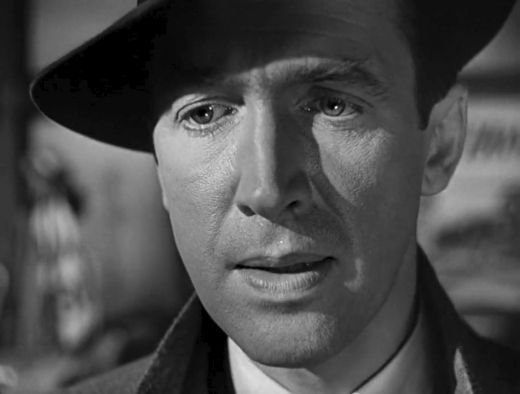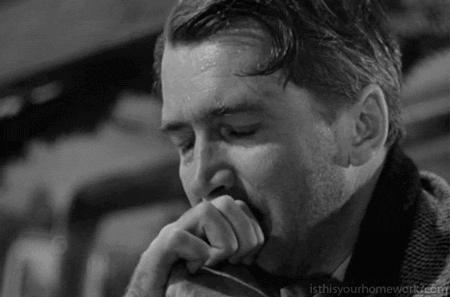If you haven’t ever seen It’s a Wonderful Life, or even if you have seen it, but don’t remember it well, do yourself a favour and go watch it. It is one of those somewhat rare classic films which still holds up amazingly well today. More than that, it isn’t at all the sappy, corny movie that most people assume it is or mis-remember it as.
Far from the cinematic snow-globe that most people mis-categorize it as, It’s a Wonderful Life is surprisingly dark, very witty, and truly entertaining.
Whether they’ve seen it or not, most know it for Jimmy Stewart as George Bailey running through Bedford Falls, yelling “Merry Christmas!”; and of course for the sacharine-sweet Zuzu proclaiming “Teacher says, every time a bell rings, an angel gets his wings!”; all culminating with the tearful reprise of Auld Lang Syne. Those are the images that everybody –everybody who doesn’t remember the film well– recalls immediately upon hearing its name. And I’d agree, if those scenes were indicative of the overall tone of the movie, it would indeed be a sappy mess, hardly worth watching, save for when you desperately need a simple and sweet bit of holiday fluff.
But that is not the feel of the movie! Far from the cinematic snow-globe that most mis-categorize it as, It’s a Wonderful Life is surprisingly dark, very witty, and truly entertaining. The film is thoroughly rewarding even to more refined modern-day audiences. And while it has been elevated to Christmas canon, very little of it actually occurs around Christmastime, and it certainly isn’t your standard holiday fare.
The first two hours of the film are a long, dark study in the psychological torture of George Bailey.
The reason for the dissonance between the perception and the reality of the film is obvious; for decades television network and advertising executives have slavishly adhered to the Law of Classic Films, the law mandating that all, and only, the most clichéd moments of classic films must be repeated, ad nauseum, in every advertisement or reference to said films.
What makes It’s a Wonderful Life such a surprise to the first-time viewer is that, while its runtime is a hearty 130 minutes, all of those oft-remembered, oft-rehashed, and awfully sweet moments occur in the final 7 minutes of the film. While the final few minutes are indeed a super-concentrated distillation of the essence of Christmas, they serve as a well-balanced counterpoint, a satisfying glaze, too sweet on its own, but just perfect as the topper to the body of the film. These clichéd, over-sweet moments work so beautifully well, because the first two hours of the film are a long, dark study in the psychological torture of George Bailey.
Hitting Close to Home
This poor, good, but not too good man constantly has his dreams dashed, all his hopes and aspirations for life repeatedly and thoroughly yanked from his reach, cruelly withdrawn just as he is about to grab for one tiny modicum of happiness, as if the world were out not just to get him, but to toy with him, to manipulate him, to drive him towards his getting himself in a cold, lonely act of miserable suicide. It’s a Wonderful Life is a hard cruel film, especially so for those who have, or have had, their own unrealized dreams.
And it is powerful because the viewer shares George’s dreams, hopes for him to leave Bedford Falls, to see the world, to build bridges, raise skyscrapers, and do the other things. We want this for George, not because those are wonderous and fanciful dreams, but because the stifling mundanity of George’s life parallels dramatically the choices and sacrifices most of us are obligated to make ourselves. We root for George to blow out of Bedford Falls, because his is a story that embodies the ‘What if?’, the secret, somewhat disappointed question in the back of our minds, that hidden promise of the paths not taken, the wistful regret which most of us share and with which all of us can sympathize.
As if unsatisfied with merely crushing his dreams, at the very moment George abandons his aspirations and settles for the life he has, the cruel world takes it all away.
So when the rug is inevitably and repeatedly yanked from beneath George’s feet, we feel its affect resonate with our own unrealized aspirations. And yet this is skillfully done; we share frustration with George’s plight, but not the cheated frustration of lazily contrived deceit, not the sort of feeling evoked when we watch Lucy yank the football out from Charlie Brown’s feet. These inevitable and endless reversals don’t share that same artifice that makes the viewer angry at the entire contrivance.
Instead, George is presented with the very real, very mundane difficulties we encounter in our own lives. And while we secretly wish that George might turn his back on his responsibilities and his family, might finally flee for his long longed-for life, ultimately George makes the decisions that we ourselves would very likely make, indeed the decisions that we ourselves very likely have made, when standing in his shoes.
George’s struggle is inherently more identifiable, more visceral to the viewer, not because the slings and arrows he suffers are of epic, earth-shaking proportion, but because they are the thousand cuts of everyday living, the constant postponement of a better life, not some unattainable fantasy, but a cloyingly close existence, a promise just out of reach, just visible on the horizon, ever receding, a tantalizing mirage that fuels thirst more sharply than would a hopelessly barren landscape.
And just when George finally submits to his destiny, when he packs away his exotic and adventurous aspirations, when he replaces them with the solidly practical dreams of a solidly practical family existence, his resignation of hope perhaps most depressing of all, when George finally appears happy with his life, at last the stage is set for one final and terrible blow. As if unsatisfied with merely crushing his dreams, at the very moment George abandons his aspirations and settles for the life he has, the cruel world takes it all away.
Despite the more momentous reversal, the viewer can still share in George’s plight. More keenly felt than the destruction of our own lives, we all know and fear the uniquely biological terror-shame of bringing ruination to one’s family and children. Little wonder that George descends into panicked madness. And when he does, we are along for the ride.
What follows is a topsy-turvy depiction of a world without George Bailey, a world of almost-familliar scenes filled with Dickensian shadows pantomiming all the base fears of the ego: friends having forgotten you, siblings dead, mother not recognizing you, your home uninhabited, children gone, and your poor wife become a spinster. Save perhaps for that last one, each of these fears resonates with us today; and all build to an intolerable torture for George Bailey, a hellish reality against which prison, poverty, and privation are preferred.
The Light at the End
It is against this backdrop of misery that the final seven minutes of the film are portrayed. After two hours of watching George take his lumps both figuratively and literally, and long after you’ve begun to wonder how on earth this film could ever be considered a Christmas movie, the unending emotional spiral finally sweeps heavenward. And it is a welcome change at that. No longer do those oft-remembered scenes taste of unbearable treacle. Instead, George’s shouts of merriment through Bedford Falls now bring joy to our hearts; Zuzu’s pronouncement of angel advancement garners nods of ascent; and the heartwarming rendition of Auld Lang Syne, now seeming more spontaneous than staged, perhaps even brings to our eyes the same heavy, happy tears seen in George’s own.
It’s a Wonderful Life is a film which absolutely deserves a first-time viewing and thoroughly rewards revisitation.
The film depicts a surprisingly grim tale, but it is not without its warmth and humour too. While ultimately descending to frighteningly dark depths before the final redemption, much of the film is filled with wonderfully enjoyable scenes, funny and touching moments that feel unexpectedly real, identifiable, scenes remembered far more fondly than the classic clichés most commonly recalled. The first act is filled with such scenes of surprisingly sharp dialog and effectively genuine moments between characters.
Many of my favourite parts are these light-hearted and genuine glimpses into the richly textured community of Bedford Falls and into the unexpectedly wry mind of George Bailey. The school dance is delightful, as is George and Mary’s walk home in its aftermath, the latter starting sweet but turing just a touch naughty. Our preconceptions of George are turned on their head when we see the arch look in his eyes, the realization dawning that a fella could have some fun with a naked girl hiding in a hydrangea bush, his playful teasing of Mary revealing a mischievous side of George Bailey that is both unexpected and fun.
So much more than a Christmas movie, It’s a Wonderful Life is a parable about hope and sacrifice and about the value of life. It is a fun film, a touching film, and, for one which features an angel (2nd-class), a surprisingly real film. It is a quality tale filled with thoroughly enjoyable moments, delightfully quirky scenes that stick with you long after the final echoes of Auld Lang Syne fade away.
It’s a Wonderful Life is a film which absolutely deserves a first-time viewing and thoroughly rewards revisitation. And why not at Christmas?











Beautiful article for a beautiful film. Thanks.
The best film of all-time, for those who understand.